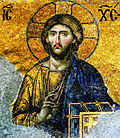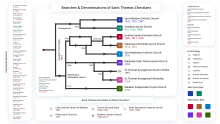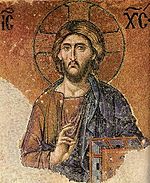کلیسای آشوری مشرق
| پرونده:Assyrian church of the East.png کلیسای آشوری کاتولیک حواری مقدس مشرق | |
|---|---|
| ܥܕܬܐ ܩܕܝܫܬܐ ܘܫܠܝܚܝܬܐ ܩܬܘܠܝܩܝ ܕܡܕܢܚܐ ܕܐܬܘܪ̈ܝܐ | |
 ساکنان پاتریکنشین قودشانس در امپراطوری عثمانی (۱۶۹۲–۱۹۱۸) | |
| کوتهنوشت | ACOE |
| طبقهبندی | مسیحیت شرقی |
| گرایش | مسیحیت سریانی |
| الهیات | نسطوری[الف][ب][۱۰][۱۱][۱۲] |
| جاثلیق-پاتریارک | جرجیس سوم |
| قلمرو هند | کلیسای سریانی کلدانی هند |
| منطقه | مرکز خاورمیانه، هند; جوامع دور از وطن |
| زبان | سریانی،[۱۳] آرامی |
| نیایشسرایی | East Syrian Rite |
| مقرها | شیکاگو، ایالات متحده در گذشته عنکاوا، اربیل، عراق |
| خاستگاه | عهد حواری |
| جذبشده(ها) | کلیسای سریانی کلدانی (دهه ۱۸۷۰) |
| جداشده(ها) | کلیسای کاتولیک کلدانی (۱۸۳۰) کلیسای باستانی مشرق (۱۹۶۸) |
| اعضا | ۳۲۳٬۳۰۰[۱۴] |
| وبگاه رسمی | |
| بخشی از مجموعههای |
| مسیحیت شرقی |
|---|
 |
| بخشی از سلسله مقالات در مورد: |
| مسیحیت |
|---|
|
|
کلیسای آشوری مشرق (به سریانی: ܥܕܬܐ ܕܡܕܢܚܐ ܕܐܬܘܖ̈ܝܐ) یا بهطور رسمی کلیسای آشوری کاتولیک حواری مقدس مشرق (به سریانی: ܥܕܬܐ ܩܕܝܫܬܐ ܘܫܠܝܚܝܬܐ ܩܬܘܠܝܩܝ ܕܡܕܢܚܐ ܕܐܬܘܪ̈ܝܐ) یک مذهب مسیحی شرقی است که در مسیحشناسی و کلیساشناسی از کلیسای تاریخی مشرق پیروی میکند. زبان اصلی این کلیسا سریانی است و اکثر پیروان آن آشوریتبار هستند.
مقر این کلیسا در گذشته در اربیل در کردستان عراق قرار داشت اما به دلیل جنگ ایران و عراق این مقر در دهه ۱۹۸۰ به شیکاگو در ایالات متحده آمریکا منتقل شد. منطقه اصلی کلیسای آشوری علاوه بر شمال عراق، شامل جنوب شرق ترکیه، شمال شرق سوریه و شمال غرب ایران نیز میشود که عمدتاً نواحی امپراتوری تاریخی آشور را شامل میشوند. از سال ۲۰۱۵، مار جرجیس سوم رهبر این فرقه است.
کلیسای آشوری مشرق ادعای پیوستگی با کلیسای تاریخی مشرق را دارد، اما با کلیسای ارتدکس مشرقی و کلیسای ارتدکس شرقی در ارتباط نیست و یک ساختار اسقفی سنتی به رهبری جاثلیق دارد.
یادداشتها[ویرایش]
- ↑ درستی نسبت دادن نستوریانیسم به نستوریوس، که کلیسای آشوری شرق او را به عنوان یک قدیس گرامی می داشت، مورد مناقشه است.[۱][۲] David Wilmshurst states that for centuries "the word 'Nestorian' was used both as a term of abuse by those who disapproved of the traditional East Syrian theology, as a term of pride by many of its defenders [...] and as a neutral and convenient descriptive term by others. Nowadays it is generally felt that the term carries a stigma".[۳] Sebastian P. Brock says: "The association between the Church of the East and Nestorius is of a very tenuous nature, and to continue to call that Church 'Nestorian' is, from a historical point of view, totally misleading and incorrect – quite apart from being highly offensive and a breach of ecumenical good manners."[۴] Apart from its religious meaning, the word "Nestorian" has also been used in an ethnic sense, as shown by the phrase "Catholic Nestorians".[۵][۶][۷] In light of the persistently misused 'Nestorian' term, Sebastian Brock, a Fellow of the British Academy, in his 1996 article entitled: The 'Nestorian' Church: a lamentable misnomer, published in the Bulletin of the John Rylands Library, called the designation for the Assyrian Church of the East as the "'Nestorian Church'"as "..both inappropriate and misleading..", quoted in the larger context: "..the term 'Nestorian Church' has become the standard designation for the ancient oriental church which in the past called itself 'The Church of the East', but which today prefers the fuller title 'The Assyrian Church of the East'. Such a designation is not only discourteous to modern members of this venerable church, but also – as this paper aims to show – both inappropriate and misleading."[۸]
- ↑ In 1994, the Common Christological Declaration between the Catholic Church and the Assyrian Church of the East marked the resolution of a dispute between those two churches that had existed since the Council of Ephesus. They expressed their common understanding of doctrine concerning the divinity and humanity of Christ, and recognized the legitimacy and rightness of their respective descriptions of Mary as, on the Assyrian side, "the Mother of Christ our God and Saviour", and, on the Catholic side, as "the Mother of God" and also as "the Mother of Christ".[۹]
منابع[ویرایش]
- ↑ J. F. Bethune-Baker, Nestorius and His Teaching (Cambridge University Press 2014), chapter VI
- ↑ Walbert Bühlmann, Dreaming about the Church (Rowman & Littlefield 1987), pp. 111 and 164
- ↑ David Wilmshurst, The Ecclesiastical Organisation of the Church of the East, 1318–1913 (Peeters 2000), p. 4
- ↑ Sebastian P. Brock, Fire from Heaven: Studies in Syriac Theology and Liturgy (Ashgate 2006), p. 14
- ↑ Joost Jongerden, Jelle Verheij, Social Relations in Ottoman Diyarbekir, 1870–1915 (BRILL 2012), p. 21
- ↑ Gertrude Lowthian Bell, Amurath to Amurath (Heinemann 1911), p. 281
- ↑ Gabriel Oussani, "The Modern Chaldeans and Nestorians, and the Study of Syriac among them" in Journal of the American Oriental Society, vol. 22 (1901), p. 81; cf. Albrecht Classen (editor), East Meets West in the Middle Ages and Early Modern Times (Walter de Gruyter 2013), p. 704
- ↑ Brock, S. P. (1996). "The 'Nestorian' Church: a lamentable misnomer". Bulletin of the John Rylands Library. 1996;78(3):23–35. Retrieved 2019-10-25.
- ↑ Common Christological Declaration between the Catholic Church and the Assyrian Church of the East بایگانیشده در ژانویه ۴, ۲۰۰۹ توسط Wayback Machine
- ↑ Joshua Castellino (2013-04-25). Minority Rights in the Middle East. ISBN 978-0-19-166888-3.
Most Assyrians are affiliated to one of four churches: the Syrian Orthodox Church, the Syrian Catholic Church, the Chaldean Uniate (Catholic), and the Assyrian Church of the East (Nestorian)
- ↑ Tang, Li; Winkler, Dietmar W. (2013). From the Oxus River to the Chinese Shores: Studies on East Syriac Christianity in China and Central Asia. ISBN 978-3-643-90329-7.
The so-called Nestorian Church is also known as the Assyrian Church of the East.
- ↑ Lee Samuel (October 2009). Understanding Japan Through the Eyes of Christian Faith Third Edition. ISBN 9789490179014.
Nestorian missionaries who represented the Assyrian Church of the East
- ↑ Holy Apostolic Assyrian Church of the East Official News Website
- ↑ "Holy Apostolic Catholic Assyrian Church of the East — World Council of Churches". www.oikoumene.org.
- مشارکتکنندگان ویکیپدیا. «Assyrian Church of the East». در دانشنامهٔ ویکیپدیای انگلیسی، بازبینیشده در ۴ ژوئن ۲۰۲۰.



